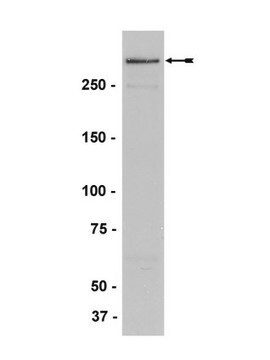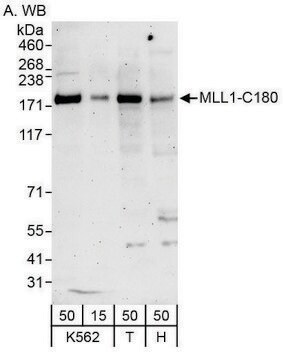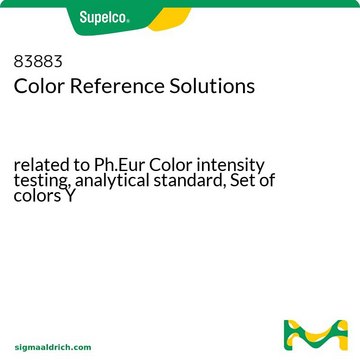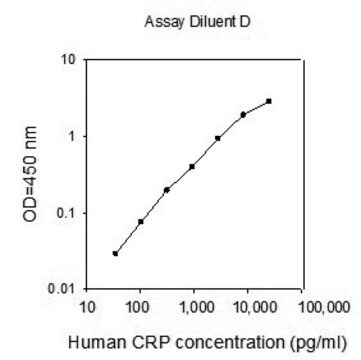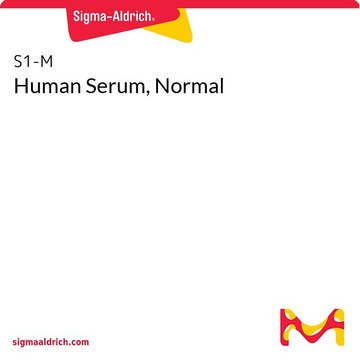05-765
Anti-MLL/HRX Antibody, CT., clone 9-12
clone 9-12, Upstate®, from mouse
Sinonimo/i:
Histone-lysine N-methyltransferase 2A, Lysine N-methyltransferase 2A, ALL-1, CXXC-type zinc finger protein 7, Myeloid/lymphoid or mixed-lineage leukemia, Myeloid/lymphoid or mixed-lineage leukemia protein 1, Trithorax-like protein, Zinc finger protein HR
About This Item
Prodotti consigliati
Origine biologica
mouse
Livello qualitativo
Forma dell’anticorpo
purified immunoglobulin
Tipo di anticorpo
primary antibodies
Clone
9-12, monoclonal
Reattività contro le specie
mouse, human
Produttore/marchio commerciale
Upstate®
tecniche
ChIP: suitable
immunofluorescence: suitable
immunoprecipitation (IP): suitable
western blot: suitable
Isotipo
IgG1
N° accesso NCBI
N° accesso UniProt
Condizioni di spedizione
wet ice
modifica post-traduzionali bersaglio
unmodified
Informazioni sul gene
human ... KMT2A(4297)
Descrizione generale
Specificità
Immunogeno
Applicazioni
Chromatin Immnuoprecipitation (ChIP) Analysis: A representative lot detected MLL occupancy at the Hoxa10 and Meis promoters in mouse MLL-AF10 leukemia cells (Gallo, M., et al. (2013). Cancer Res. 73(1):417-427).
Chromatin Immnuoprecipitation (ChIP) Analysis: A representative lot detected an enhanced MLL occupancy at the Ink4a locus of 8-month-old than 2-month-old bEzTG mouse islets. The same age-dependent Ink4a locus enrichment was observed with H3K4me3, while the opposite trend was seen with Ezh and H3K27me3 enrichment at the same locus (Zhou, J.X., et al. (2013). J. Clin. Invest. 123(11):4849-4858).
Chromatin Immnuoprecipitation (ChIP) Analysis: A representative lot detected MLL occupancy at the HOXA10 promoter region in G179NS and G411NS human glioblastoma neural stem cells (Gallo, M., et al. (2013). Cancer Res. 73(1):417-427).
Chromatin Immnuoprecipitation (ChIP) Analysis: A representative lot detected MLL occupancy at the DNA replication origin (RD) as well as at both exon 1b and p16INK4a/p19ARF shared exon 2 in mouse embryonic fibroblast (MEF). An increased MLL enrichment at these sites was observed in senescent and Polycomb mutant MEFs (Agherbi, H., et al. (2009). PLoS One. 4(5):e5622).
Chromatin Immnuoprecipitation (ChIP) Analysis: A representative lot detected MLL occupancy at the Hoxa9 AB region using mouse embryonic fibroblast (MEF) chromatin preparation (Erfurth, F.E., et al. (2008). Proc. Natl. Acad. Sci. U.S.A. 105(21):7517-7522).
Immnuoprecipitation Analysis: A representative lot co-immunoprecipitated JmjD3 and RbBP5, but not Dnmt3a, with MLL from Min6 mouse insulinoma cell extract (Zhou, J.X., et al. (2013). J. Clin. Invest. 123(11):4849-4858).
Western Blotting Analysis: A representative lot detected higher MLL level in cultured glioblastoma neural stem (GNS) cells than neural stem (NS) cells, as well as MLL enrichment in the CD15+ fraction of freshly resected Glioblastoma (GBM) cells (Gallo, M., et al. (2013). Cancer Res. 73(1):417-427).
Western Blotting Analysis: A representative lot detected SET domain-containing C-terminal fragment of the MLL complex enzymatic subunit MLL (C180; MLLC) in anti-FLAG immunoprecipitate from HeLaS cells stably expressing FLAG-tagged hDPY-30 (Cho, Y.W., et al. (2007). J. Biol. Chem. 282(28):20395-20406).
Epigenetics & Nuclear Function
Histones
Qualità
Western Blotting Analysis: 0.1-1 µg/mL of this antibody detected MLL C-terminal fragment (C180; MLLC) in K562 nuclear extract.
Descrizione del bersaglio
Stato fisico
Stoccaggio e stabilità
Risultati analitici
K562 nuclear extract
Altre note
Note legali
Esclusione di responsabilità
Non trovi il prodotto giusto?
Prova il nostro Motore di ricerca dei prodotti.
Codice della classe di stoccaggio
10 - Combustible liquids
Classe di pericolosità dell'acqua (WGK)
WGK 1
Certificati d'analisi (COA)
Cerca il Certificati d'analisi (COA) digitando il numero di lotto/batch corrispondente. I numeri di lotto o di batch sono stampati sull'etichetta dei prodotti dopo la parola ‘Lotto’ o ‘Batch’.
Possiedi già questo prodotto?
I documenti relativi ai prodotti acquistati recentemente sono disponibili nell’Archivio dei documenti.
Il team dei nostri ricercatori vanta grande esperienza in tutte le aree della ricerca quali Life Science, scienza dei materiali, sintesi chimica, cromatografia, discipline analitiche, ecc..
Contatta l'Assistenza Tecnica.